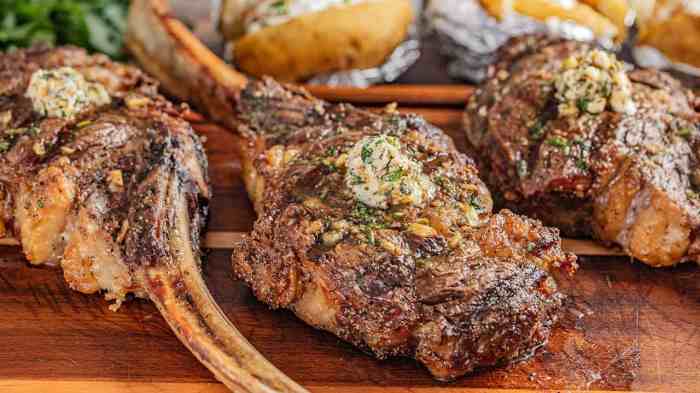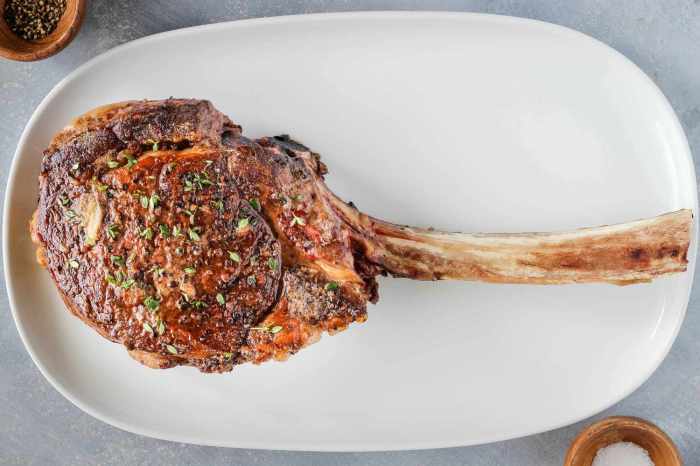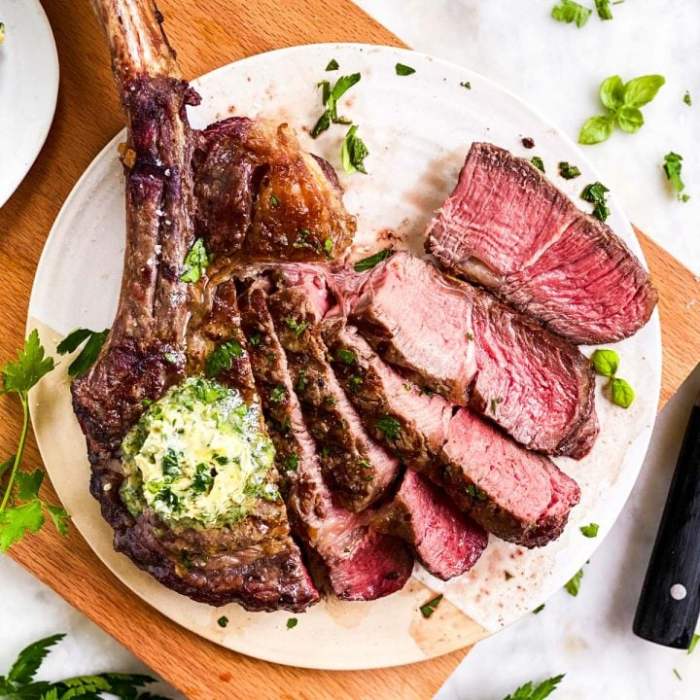Tomahawk steak recipe is a culinary adventure that brings together the bold flavors of a bone-in ribeye with the impressive visual appeal of a long, curved bone. This cut of beef, often weighing in at over 30 ounces, is a true centerpiece for any special occasion, promising an unforgettable dining experience.
From selecting the perfect steak to mastering the art of grilling, this guide provides a comprehensive approach to crafting a tomahawk steak masterpiece.
The tomahawk steak’s history traces back to the early days of cattle ranching, where the bone-in ribeye was a prized cut for its rich flavor and tenderness. Today, it has become a culinary icon, celebrated for its dramatic presentation and the satisfying experience of carving the meat off the bone.
Tomahawk Steak

The tomahawk steak, with its dramatic bone-in structure and impressive size, has become a culinary icon. This cut of beef, prized for its tenderness, marbling, and visual appeal, has a fascinating history and distinct characteristics.
Origin and History
The tomahawk steak’s history is intertwined with the evolution of cattle ranching in the American West. The name “tomahawk” likely arose from the resemblance of the bone to the Native American weapon. While the exact origins of the cut are unclear, it gained popularity in the late 20th century, becoming a staple in upscale restaurants and steakhouses.
Characteristics of a Tomahawk Steak
The tomahawk steak is a bone-in ribeye, characterized by its long, curved bone that extends beyond the meat. This bone serves as a handle, making it easier to grip and carve. The cut typically weighs between 2-4 pounds, making it a substantial portion ideal for sharing or a special occasion meal.
Marbling and Fat Content
Tomahawk steaks are known for their generous marbling, which refers to the streaks of fat interlaced throughout the muscle. This marbling contributes to the steak’s rich flavor, tenderness, and juiciness. The fat content of a tomahawk steak can vary, but it generally ranges from 10% to 20%, depending on the grade of beef.
Selecting the Perfect Tomahawk Steak
Choosing the right Tomahawk steak is crucial for a memorable dining experience. It’s not just about the impressive size; the quality of the meat itself plays a significant role in the final taste and texture. This guide will help you navigate the selection process, ensuring you pick the perfect cut for your next culinary adventure.
Marbling, Color, and Texture
Marbling, the intramuscular fat distributed throughout the meat, is a key indicator of flavor and tenderness. Look for a steak with abundant marbling, appearing as fine white streaks throughout the muscle. The more marbling, the richer the flavor and juicier the steak.
The color of the meat should be a vibrant red, indicating freshness. Avoid steaks that are brown or discolored, as this could suggest spoilage. The texture should be firm and springy to the touch, signifying a high-quality cut.
Identifying Proper Aging
Dry-aging is a process where beef is hung in a controlled environment, allowing enzymes to break down proteins, resulting in a more tender and flavorful steak. A properly aged Tomahawk steak will have a slightly darker color, a more intense aroma, and a slightly dry surface.
Look for steaks that have been aged for 21-45 days for optimal tenderness and flavor.
Cuts of Beef for Tomahawk Steak
The Tomahawk steak is typically cut from the ribeye, a highly marbled cut known for its rich flavor and buttery texture. However, other cuts, such as the strip steak or even the chuck eye, can also be used to create a Tomahawk-style cut.
Mastering the Tomahawk Steak Recipe
Now that you’ve selected the perfect tomahawk steak, it’s time to get grilling. Whether you’re a seasoned grill master or a novice, this comprehensive guide will walk you through the steps to achieve a perfectly cooked tomahawk steak that will impress even the most discerning palate.
Grilling a Tomahawk Steak to Perfection
Grilling a tomahawk steak requires careful attention to temperature and timing to ensure a juicy, flavorful, and perfectly cooked steak. Here’s a step-by-step guide:
- Prepare the Grill:Preheat your grill to medium-high heat (about 450-500°F). If using a gas grill, ensure all burners are evenly heated. If using a charcoal grill, use a chimney starter to get the coals glowing red.
- Season the Steak:Liberally season the steak with salt, pepper, and any other desired herbs or spices. For a more robust flavor, consider using a dry rub. Allow the steak to sit at room temperature for about 30 minutes before grilling.
- Grill the Steak:Place the steak on the hot grill and cook for about 3-4 minutes per side for a medium-rare steak. For a more well-done steak, increase the grilling time accordingly. Be sure to rotate the steak 90 degrees halfway through grilling to ensure even cooking.
- Check for Doneness:Use a meat thermometer to check the internal temperature of the steak. The recommended internal temperature for medium-rare is 130-135°F. If using a meat thermometer, insert it into the thickest part of the steak without touching bone.
- Rest the Steak:Once the steak has reached the desired internal temperature, remove it from the grill and let it rest for 5-10 minutes before slicing and serving. This allows the juices to redistribute throughout the steak, resulting in a more tender and flavorful cut.
Reverse Sear Method, Tomahawk steak recipe
The reverse sear method is a popular technique for achieving a perfectly cooked steak with a juicy interior and a flavorful crust. This method involves cooking the steak at a low temperature for an extended period, followed by a quick sear over high heat.
- Prepare the Oven:Preheat your oven to 250°F. This low temperature will allow the steak to cook slowly and evenly, ensuring a tender and juicy result.
- Season the Steak:Season the steak liberally with salt, pepper, and any other desired herbs or spices. Allow the steak to sit at room temperature for about 30 minutes before cooking.
- Cook in the Oven:Place the steak on a wire rack set over a baking sheet. Cook the steak in the preheated oven for about 1-1.5 hours, or until the internal temperature reaches 120-125°F for medium-rare. This slow cooking process will ensure the steak is cooked evenly throughout.
- Sear the Steak:Once the steak has reached the desired internal temperature, remove it from the oven and increase the grill temperature to high heat (about 500-550°F). Place the steak on the hot grill and sear for about 1-2 minutes per side to create a flavorful crust.
Be sure to rotate the steak 90 degrees halfway through searing.
- Rest the Steak:After searing, remove the steak from the grill and let it rest for 5-10 minutes before slicing and serving. This allows the juices to redistribute throughout the steak, resulting in a more tender and flavorful cut.
Seasoning Techniques
Seasoning a tomahawk steak is an essential step in achieving a flavorful and satisfying meal. The right combination of herbs, spices, and rubs can enhance the natural flavors of the steak and create a culinary masterpiece.
- Salt and Pepper:The most basic, yet essential, seasoning for any steak. Use kosher salt and freshly ground black pepper for optimal flavor.
- Herbs:Fresh or dried herbs can add a burst of flavor to your steak. Popular choices include rosemary, thyme, oregano, garlic, and parsley.
- Spices:Spices like paprika, chili powder, cumin, and garlic powder can add depth and complexity to the flavor profile. Consider creating a custom blend to suit your taste preferences.
- Dry Rubs:Dry rubs are a combination of herbs, spices, and sometimes salt and pepper, that are applied to the steak before cooking. They create a flavorful crust and enhance the overall taste of the steak. Many pre-made dry rubs are available, or you can create your own using your favorite ingredients.
Tomahawk Steak Cooking Techniques
The tomahawk steak, with its impressive bone-in presentation, demands a cooking method that not only renders it juicy and flavorful but also maintains its structural integrity. Choosing the right technique depends on your desired level of doneness, the equipment available, and your personal preferences.
Discover more by delving into canned corn recipes further.
Let’s explore some of the most popular methods for cooking a tomahawk steak.
Comparing Cooking Methods
Each cooking method has its own advantages and disadvantages, impacting the final outcome of your tomahawk steak. This table summarizes the key aspects of each method:
| Method | Advantages | Disadvantages |
|---|---|---|
| Grilling |
|
|
| Pan-Searing |
|
|
| Oven Roasting |
|
|
Achieving Different Levels of Doneness
Regardless of the cooking method, achieving the desired level of doneness for your tomahawk steak is crucial. Here’s a guide to help you:
- Rare:Internal temperature of 125°F (52°C), with a red center and cool to the touch.
- Medium-Rare:Internal temperature of 130°F (54°C), with a pink center and slightly warm to the touch.
- Medium:Internal temperature of 140°F (60°C), with a pink center that is slightly warm to the touch.
- Medium-Well:Internal temperature of 150°F (65°C), with a slightly pink center that is warm to the touch.
- Well-Done:Internal temperature of 160°F (71°C), with a brown center that is hot to the touch.
It’s important to note that these temperatures are guidelines and can vary slightly depending on the thickness of the steak and personal preference. Always use a meat thermometer to ensure accuracy.
Accompanying Dishes and Sauces: Tomahawk Steak Recipe

A tomahawk steak, with its impressive size and rich flavor, deserves equally impressive accompaniments. The right side dishes and sauces can elevate the dining experience, creating a symphony of taste and texture.
Side Dishes
A tomahawk steak’s boldness calls for side dishes that complement its robust flavor without overpowering it. Here are some suggestions:
- Roasted Vegetables:The earthy sweetness of roasted vegetables like asparagus, Brussels sprouts, or root vegetables provides a beautiful contrast to the steak’s richness.
- Creamy Mashed Potatoes:The creamy texture and buttery flavor of mashed potatoes offer a comforting counterpoint to the steak’s chewiness.
- Green Salad:A refreshing green salad with a light vinaigrette provides a palate cleanser and adds a touch of acidity to balance the steak’s richness.
- Grilled Corn on the Cob:The smoky sweetness of grilled corn on the cob adds another layer of flavor and complements the steak’s char.
- Mac and Cheese:A classic comfort food, mac and cheese provides a creamy and cheesy counterpoint to the steak’s savory flavor.
Steak Sauces
Steak sauces add another dimension of flavor to the tomahawk steak, enhancing its natural taste and adding complexity.
- Béarnaise Sauce:This classic French sauce is made with clarified butter, egg yolks, tarragon, and white wine vinegar. Its rich, creamy texture and tangy flavor pair beautifully with the steak’s richness.
- Chimichurri Sauce:This Argentinian sauce is made with fresh herbs, garlic, olive oil, and vinegar. Its vibrant, herbaceous flavor adds a refreshing contrast to the steak’s savory notes.
- Peppercorn Sauce:This classic sauce is made with black peppercorns, cream, and butter. Its peppery kick adds a touch of heat and complexity to the steak’s flavor.
Wine Pairings
Choosing the right wine to complement a tomahawk steak depends on the cooking method and desired flavor profile. Here’s a guide to pairing wine with tomahawk steak:
| Cooking Method | Flavor Profile | Wine Pairing |
|---|---|---|
| Grilled | Charred, smoky | Cabernet Sauvignon, Zinfandel, Syrah |
| Pan-Seared | Rich, savory | Merlot, Pinot Noir, Malbec |
| Reverse Sear | Tender, juicy | Bordeaux Blend, Cabernet Franc, Sangiovese |
Tomahawk Steak Presentation

A perfectly cooked Tomahawk steak deserves a presentation that reflects its grandeur. The way you plate this impressive cut of meat can elevate the dining experience, making it a truly memorable meal.
Plating a Tomahawk Steak
The ideal plating for a Tomahawk steak focuses on highlighting its natural beauty and providing a visually appealing contrast. The steak should be the centerpiece, with side dishes and sauces complementing its flavor profile.
- Serving Temperature:The steak should be served piping hot, ideally at an internal temperature of 130-135°F for medium-rare. This ensures a juicy and tender steak with a flavorful sear.
- Garnishes:Simple garnishes can enhance the presentation without overpowering the steak’s flavor. Consider using fresh herbs like rosemary or thyme, a sprig of parsley, or a few slices of lemon.
- Side Dishes:Choose side dishes that complement the steak’s richness and provide a balance of flavors and textures. Roasted vegetables, creamy mashed potatoes, or a light salad are excellent choices.
- Sauces:A rich and flavorful sauce can elevate the steak’s taste and add another dimension to the presentation. Red wine sauce, béarnaise sauce, or a simple herb butter are popular choices.
Visual Representation of a Beautifully Presented Tomahawk Steak
Imagine a thick, bone-in Tomahawk steak resting on a bed of creamy mashed potatoes, its crusty exterior glistening with a rich red wine sauce. A few sprigs of rosemary and a sprinkle of sea salt adorn the steak, adding a touch of rustic elegance.
On the side, a medley of roasted vegetables, vibrant with color and flavor, provides a healthy contrast. The entire dish is presented on a rustic wooden platter, enhancing the steak’s natural beauty and creating a sense of warmth and authenticity.
Carving a Tomahawk Steak
Properly carving a Tomahawk steak is essential for optimal presentation and serving. The bone acts as a natural handle, making it easier to carve the steak into individual portions. Use a sharp carving knife to slice the steak against the grain, ensuring tender and evenly sized pieces.
- Start by removing the bone:Use a sharp knife to carefully separate the bone from the steak, working from the bottom of the bone towards the top.
- Slice the steak:Once the bone is removed, slice the steak into individual portions, about 1-inch thick.
- Arrange the slices:Arrange the sliced steak on a platter, alongside the side dishes and sauces.
Conclusive Thoughts
Embarking on the journey of preparing a tomahawk steak is not just about cooking a meal; it’s about creating a culinary experience that captivates the senses and leaves a lasting impression. From the careful selection of a high-quality steak to the meticulous execution of grilling techniques, every step contributes to the final masterpiece.
So, gather your ingredients, sharpen your skills, and prepare to elevate your culinary game with the majestic tomahawk steak.
